Arc_EffNet: A Novel Series Arc Fault Detection Method Based on Lightweight Neural Network
Abstract
:1. Introduction
- To collect the arc fault current, a series arc fault test platform is constructed. It is split into four groups based on the operating principle of the load, and the time and frequency domain features of the arc current of various types of loads are investigated. Data were collected using the test platform and a series arc fault dataset was created.
- We improved the traditional EffNet network structure and constructed an Arc_EffNet arc fault detection model. The learning rate update strategy and the automatic stop training strategy are designed to keep the model from falling into the local optimal solution and from overfitting. The results of the experiment reveal that the Arc_EffNet model has a detection accuracy of 99.75%.
- The advantages and disadvantages of various embedded platforms are analyzed for deciding on the Raspberry Pi 4B platform for building an arc fault detecting device. The Arc_EffNet model is performed using the Raspberry Pi platform, and the arc fault detection algorithm is designed to detect series arc faults. Experiments are used to validate the detecting device’s performance in accordance with the IEC 62606 standard.
2. Data Collection and Analysis
2.1. Arc Fault Test Platform
2.2. Analysis of Arc Fault Current Features
3. Lightweight Technology of Convolutional Neural Network
3.1. Convolutional Neural Network and Lightweight Method
3.2. Effnet Neural Network
4. Methodology: Arc_EffNet
4.1. Improved Effnet Model
4.2. Arc_EffNet Training Strategy Optimization and Result Analysis
5. Arc Fault Detection Device
5.1. Arc Fault Detection Device Design
5.2. Experimental Verification
6. Conclusions
Author Contributions
Funding
Data Availability Statement
Conflicts of Interest
References
- IEA. Electricity Market Report—Update 2023, IEA, Paris. 2023. Available online: https://www.iea.org/reports/electricity-market-report-update-2023 (accessed on 1 January 2023).
- Fire and Rescue Department. National Fire and Police Situation. 2022. Available online: https://www.119.gov.cn/article/41kpo4CAQyv (accessed on 1 March 2022).
- Campbell, R. Home Fires Caused by Electrical Failure or Malfunction, National Fire Protection Association. 2022. Available online: https://www.nfpa.org/-/media/Files/News-and-Research/Fire-statistics-and-reports/US-Fire-Problem/Fire-causes/osHomeElectricalFires.pdf (accessed on 20 March 2022).
- IEC 62606-2017; General Requirements for Arc Fault Detection Devices. 2017. Available online: https://webstore.iec.ch/publication/27190 (accessed on 20 March 2022).
- Yong, J.; Xiao, B. Accurate harmonic model of typical single-phase nonlinear load and its harmonic attenuation features. Proc. CSEE 2014, 19, 55–62. [Google Scholar]
- Zhu, G.; Mou, L. Optimal control of distributed harmonic governance of multi-feeder low-voltage distribution network. Trans. China Electrotech. Soc. 2016, 31, 25–33. [Google Scholar]
- Chen, S.; Li, X.; Xie, Z.; Meng, Y. Time–Frequency Distribution Feature and Model Simulation of Photovoltaic Series Arc Fault With Power Electronic Equipment. IEEE J. Photovolt. 2019, 9, 1128–1137. [Google Scholar] [CrossRef]
- Kim, J.C.; Neacşu, D.O.; Lehman, B.; Ball, R. Series AC Arc Fault Detection Using Only Voltage Waveforms. In Proceedings of the 2019 IEEE Applied Power Electronics Conference and Exposition (APEC), Anaheim, CA, USA, 17–21 March 2019; pp. 2385–2389. [Google Scholar]
- Ilman, A.F. Low Voltage Series Arc Fault Detecting with Discrete Wavelet Transform. In Proceedings of the 2018 International Conference on Applied Engineering (ICAE), Batam, Indonesia, 3–4 October 2018; pp. 1–5. [Google Scholar]
- Xu, N.; Yang, Y.; Jin, Y.; He, J. Identification of Series Fault Arc of Low-voltage Power Cables in Substation Based on Wavelet Transform. In Proceedings of the 2020 IEEE 5th International Conference on Integrated Circuits and Microsystems (ICICM), Nanjing, China, 23–25 October 2020; pp. 188–192. [Google Scholar]
- Wang, W.; Li, J.; Lu, S. Application of Signal Denoising Technology Based on Improved Spectral Subtraction in Arc Fault Detection. Electronics 2023, 12, 3147. [Google Scholar] [CrossRef]
- Moon, W.-S.; Kim, J.-C.; Jo, A.; Bang, S.-B.; Koh, W.-S. Ignition Features of Residential Series Arc Faults in 220-V HIV Wires. IEEE Trans. Ind. Appl. 2015, 51, 2054–2059. [Google Scholar] [CrossRef]
- Qiongfang, Y.; Gaolu, H.; Yi, Y. Low Voltage Ac Series Arc Fault Detection Method Based on Parallel Deep Convolutional Neural Network. In IOP Conference Series: Materials Science and Engineering; IOP Publishing: Bristol, UK, 2019; Volume 490, p. 7. [Google Scholar]
- Han, X.; Li, D.; Huang, L.; Huang, H.; Yang, J.; Zhang, Y.; Wu, X.; Lu, Q. Series Arc Fault Detection Method Based on Category Recognition and Artificial Neural Network. Electronics 2020, 9, 1367. [Google Scholar] [CrossRef]
- Yin, Z.; Wang, L.; Zhang, Y.; Gao, Y. A Novel Arc Fault Detection Method Integrated Random Forest, Improved Multi-scale Permutation Entropy and Wavelet Packet Transform. Electronics 2019, 8, 396. [Google Scholar] [CrossRef]
- Wang, Y.; Hou, L.; Paul, K.C.; Ban, Y.; Chen, C.; Zhao, T. ArcNet: Series AC Arc Fault Detection Based on Raw Current and Convolutional Neural Network. IEEE Trans. Ind. Inf. 2022, 18, 77–86. [Google Scholar] [CrossRef]
- Yang, K.; Chu, R.; Zhang, R.; Xiao, J.; Tu, R. A novel methodology for series arc fault detection by temporal domain visualization and convolutional neural network. Sensors 2020, 20, 162. [Google Scholar] [CrossRef] [PubMed]
- Wang, Y.; Zhang, F.; Zhang, S. A New Methodology for Identifying Arc Fault by Sparse Representation and Neural Network. IEEE Trans. Instrum. Meas. 2018, 67, 2526–2537. [Google Scholar] [CrossRef]
- Shen, Y.-L.; Xu, Z. Fast Detection of Weak Arc Faults Based on Progressive Singular-Value-Decomposition and Empirical Analyses. IEEE Access 2022, 10, 130586–130601. [Google Scholar] [CrossRef]
- Siegel, J.E.; Pratt, S.; Sun, Y.; Sarma, S.E. Real-time deep neural networks for internet-enabled arc-fault detection. Eng. Appl. Artif. Intell. 2018, 74, 35–42. [Google Scholar] [CrossRef]
- Liu, Y.; Guo, F.; Wang, Z.; Chen, C.; Li, Y. Study on spectral features of series arc fault based on information entropy. Trans. China Electrotech. Soc. 2015, 30, 488–495. [Google Scholar]
- Zeng, J.; Chen, Y.; Lin, X.; Qin, C.; Wang, Y.; Zhu, J.; Tian, L.; Zhai, Y.; Gan, J. An Ultra-lightweight Finger Vulture Real-time Segmentation Network. Acta Photonica Sin. 2022, 51, 287–302. [Google Scholar]
- Ido, F.; Lutz, R.; Anton, K. EffNet: An Efficient Structure for Convolutional Neural Networks. arXiv 2018, arXiv:1801.06434. [Google Scholar]
- Chang, L.; Hongtao, L. A Highly Efficient Training-Aware Convolutional Neural Network Compression Paradigm. In Proceedings of the 2020 IEEE International Conference on Multimedia & Expo Workshops (ICMEW), London, UK, 6–10 July 2020; pp. 1–6. [Google Scholar]
- Ge, D.; Li, H.; Zhang, L.; Liu, R.; Shen, P.; Miao, Q. Survey of Lightweight Neural Network. J. Softw. 2020, 31, 2627–2653. [Google Scholar]
- Zhang, X.; Zhou, X.; Lin, M.; Sun, J. ShuffleNet: An Extremely Efficient Convolutional Neural Network for Mobile Devices. In Proceedings of the 2018 IEEE/CVF Conference on Computer Vision and Pattern Recognition, Salt Lake City, UT, USA, 18–22 June 2018; pp. 6848–6856. [Google Scholar]
- Freeman, I.; Roese-Koerner, L.; Kummert, A. Effnet: An Efficient Structure for Convolutional Neural Networks. In Proceedings of the 2018 25th IEEE International Conference on Image Processing (ICIP), Athens, Greece, 7–10 October 2018; pp. 6–10. [Google Scholar]
- Szegedy, C.; Vanhoucke, V.; Ioffe, S.; Shlens, J.; Wojna, Z. Rethinking the Inception Architecture for Computer Vision. In Proceedings of the 2016 IEEE Conference on Computer Vision and Pattern Recognition (CVPR), Las Vegas, NV, USA, 27–30 June 2016; pp. 2818–2826. [Google Scholar]


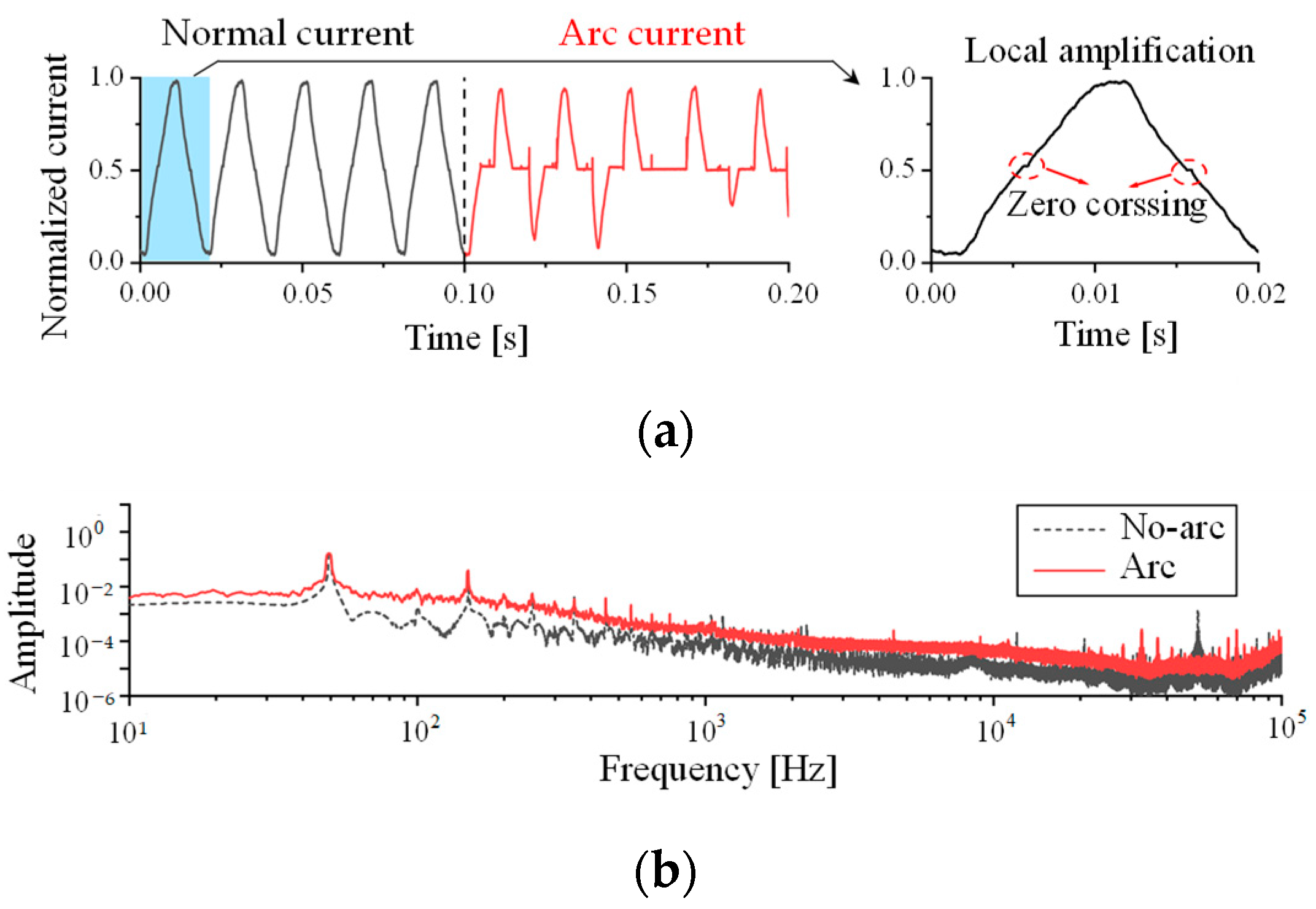
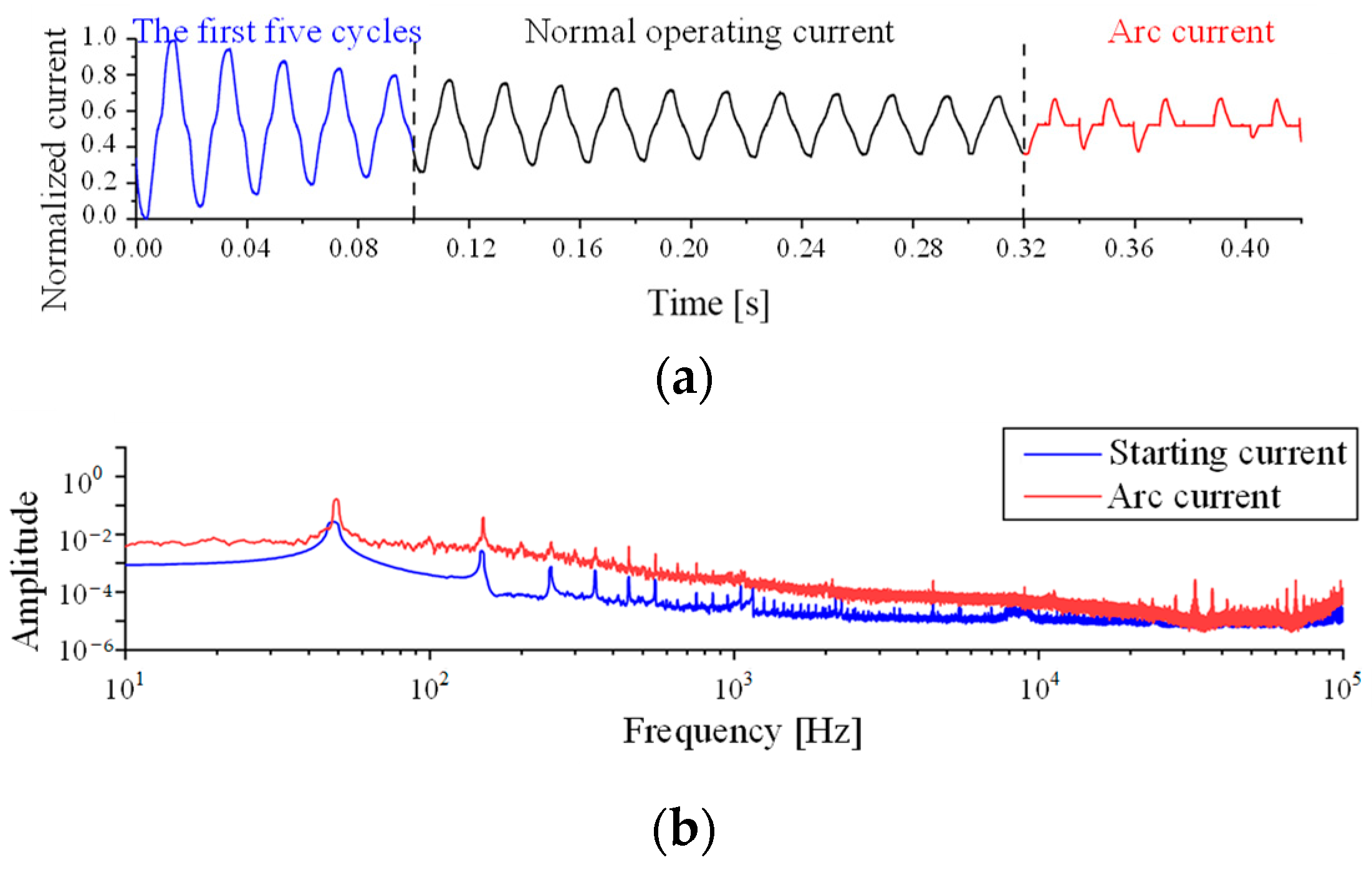
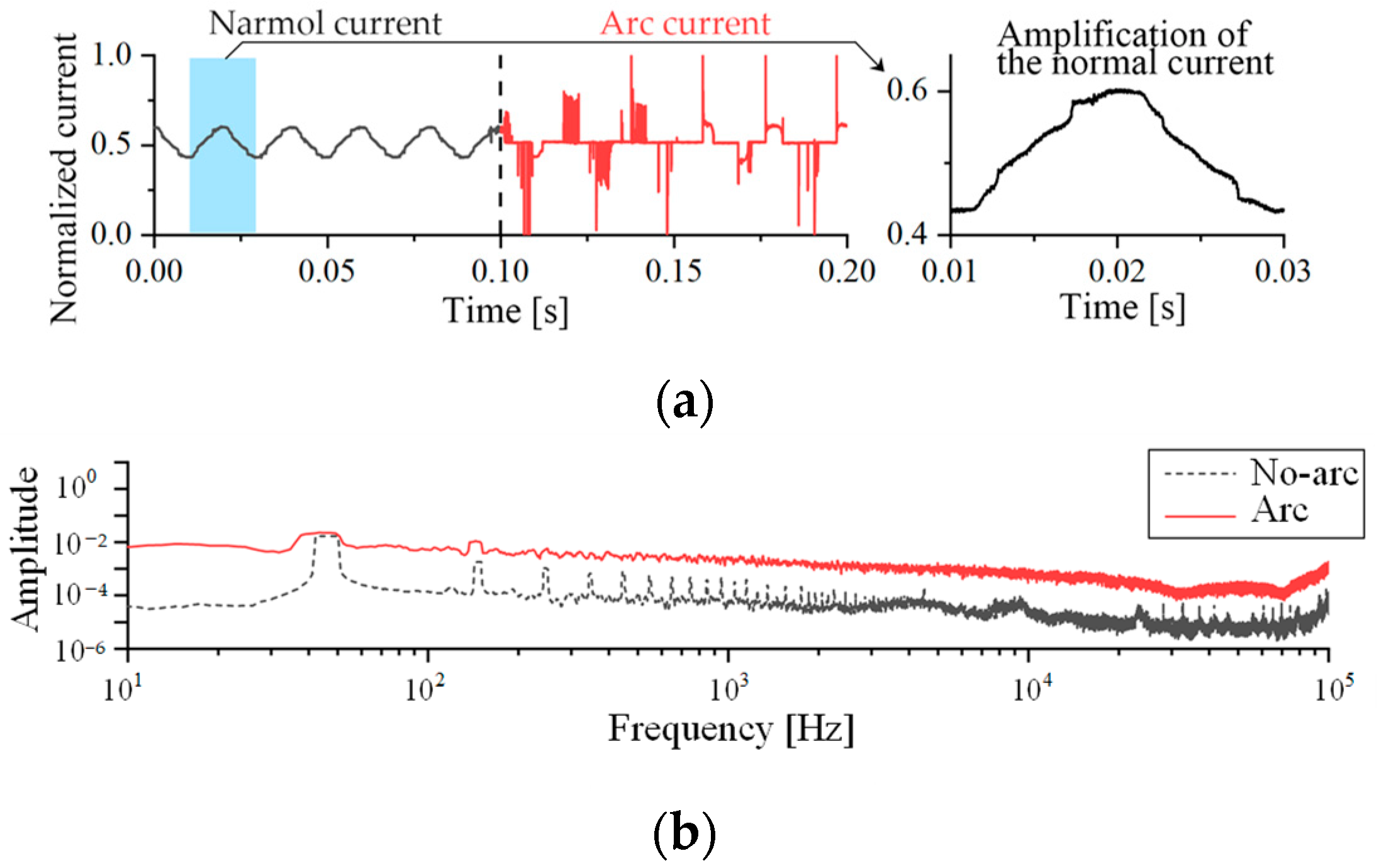

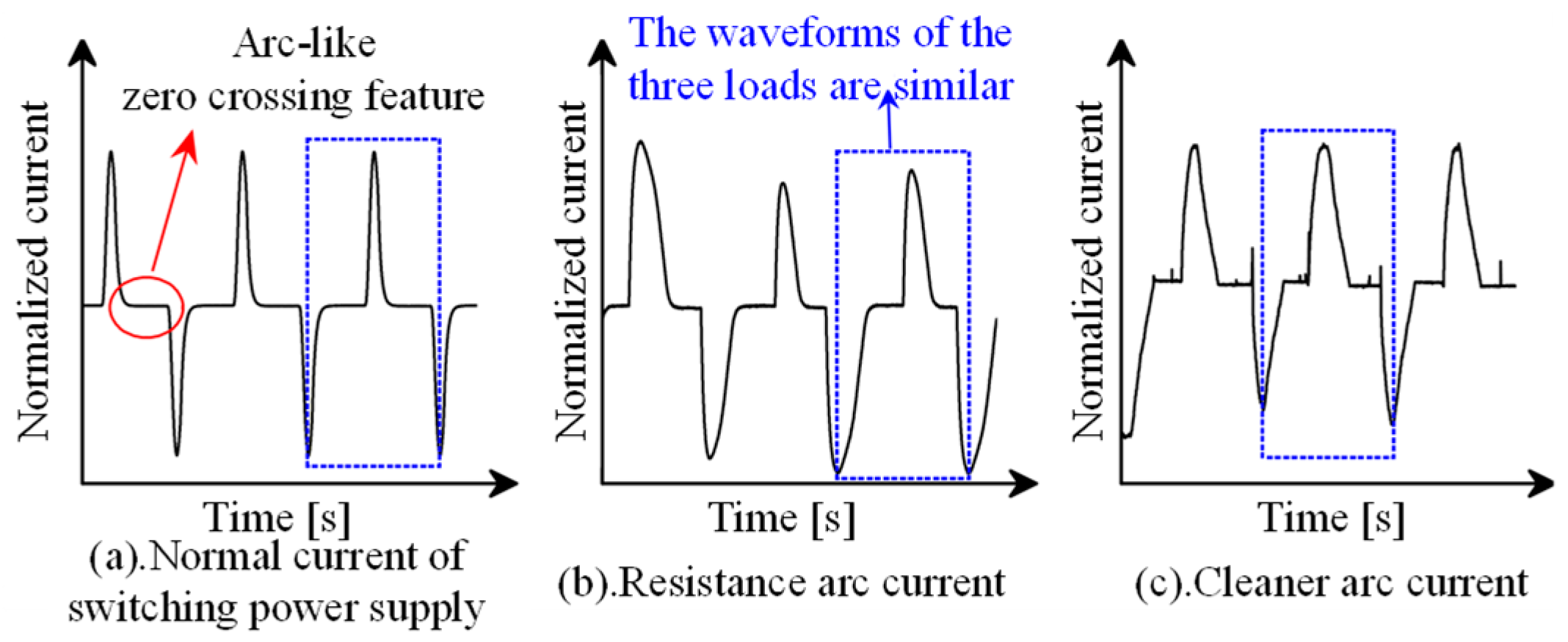
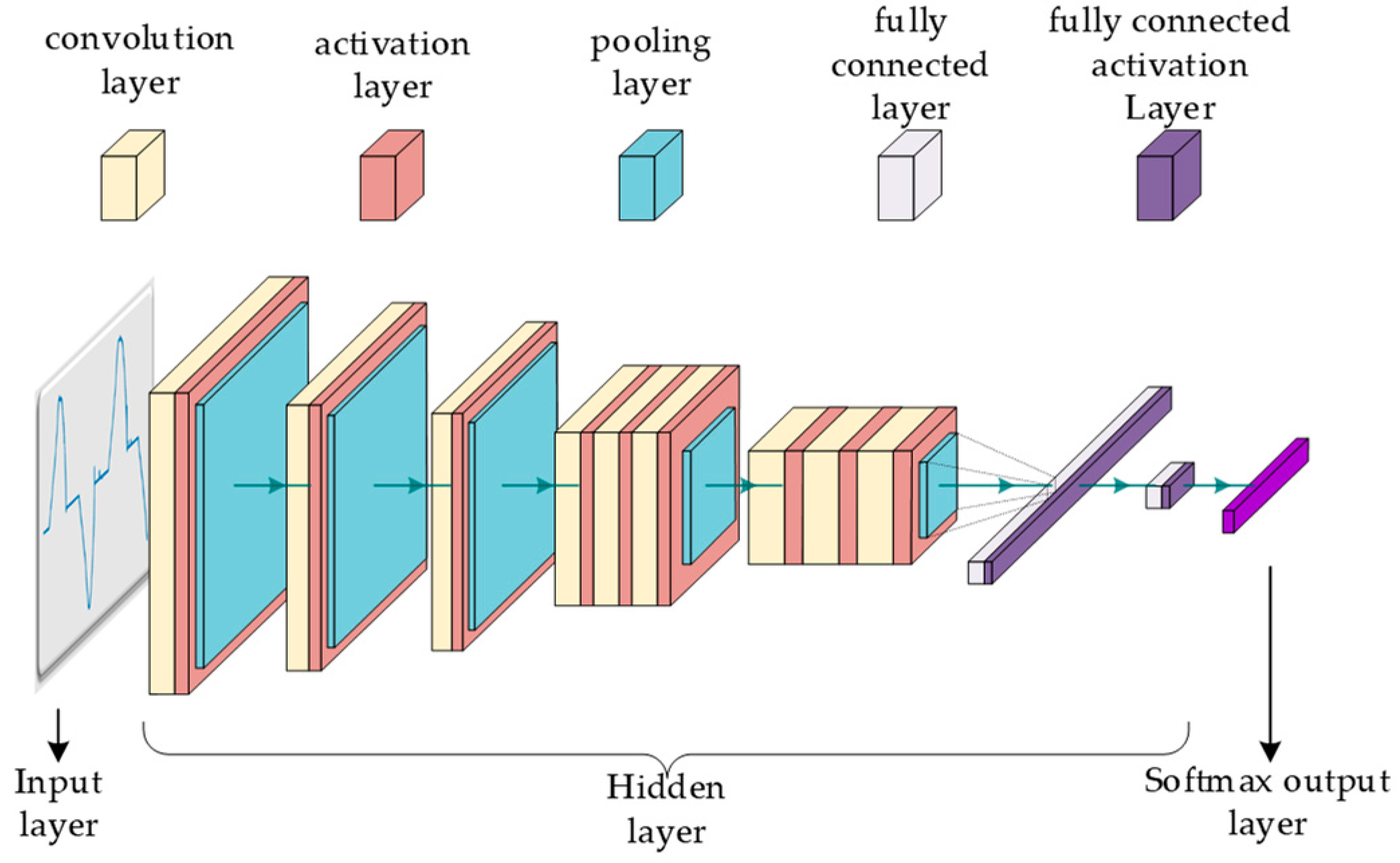

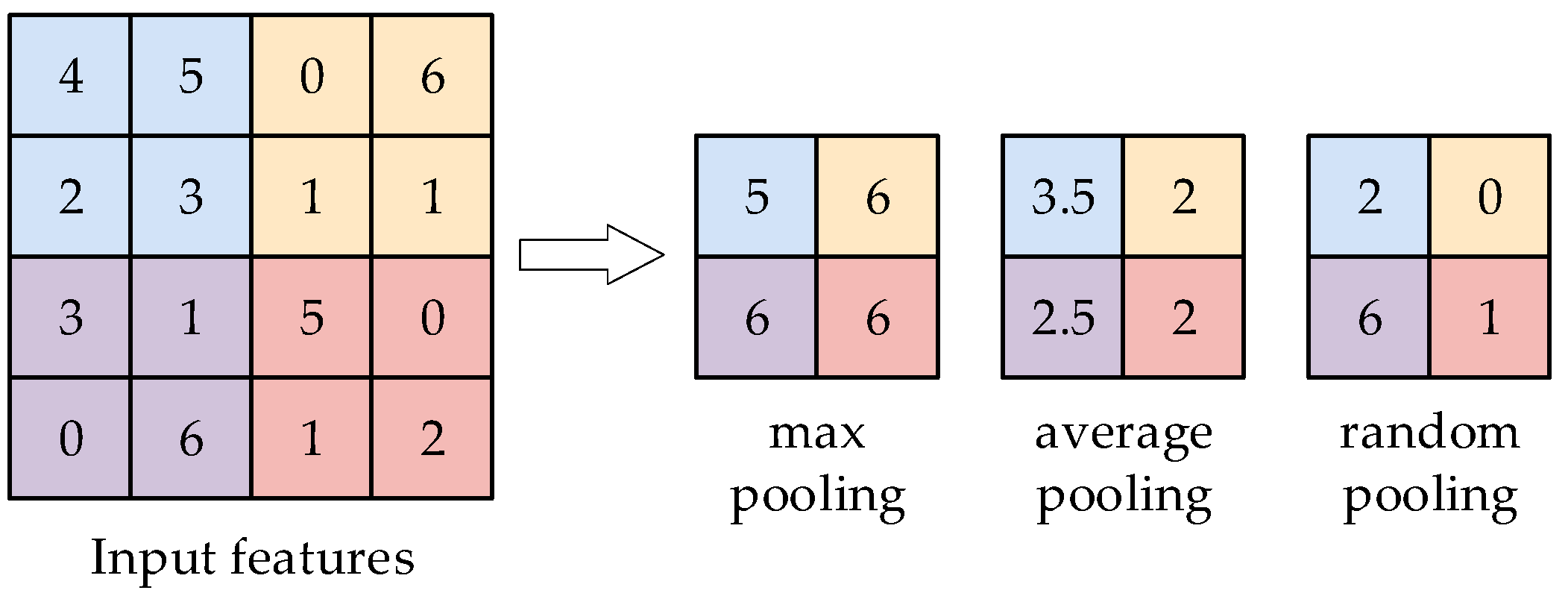
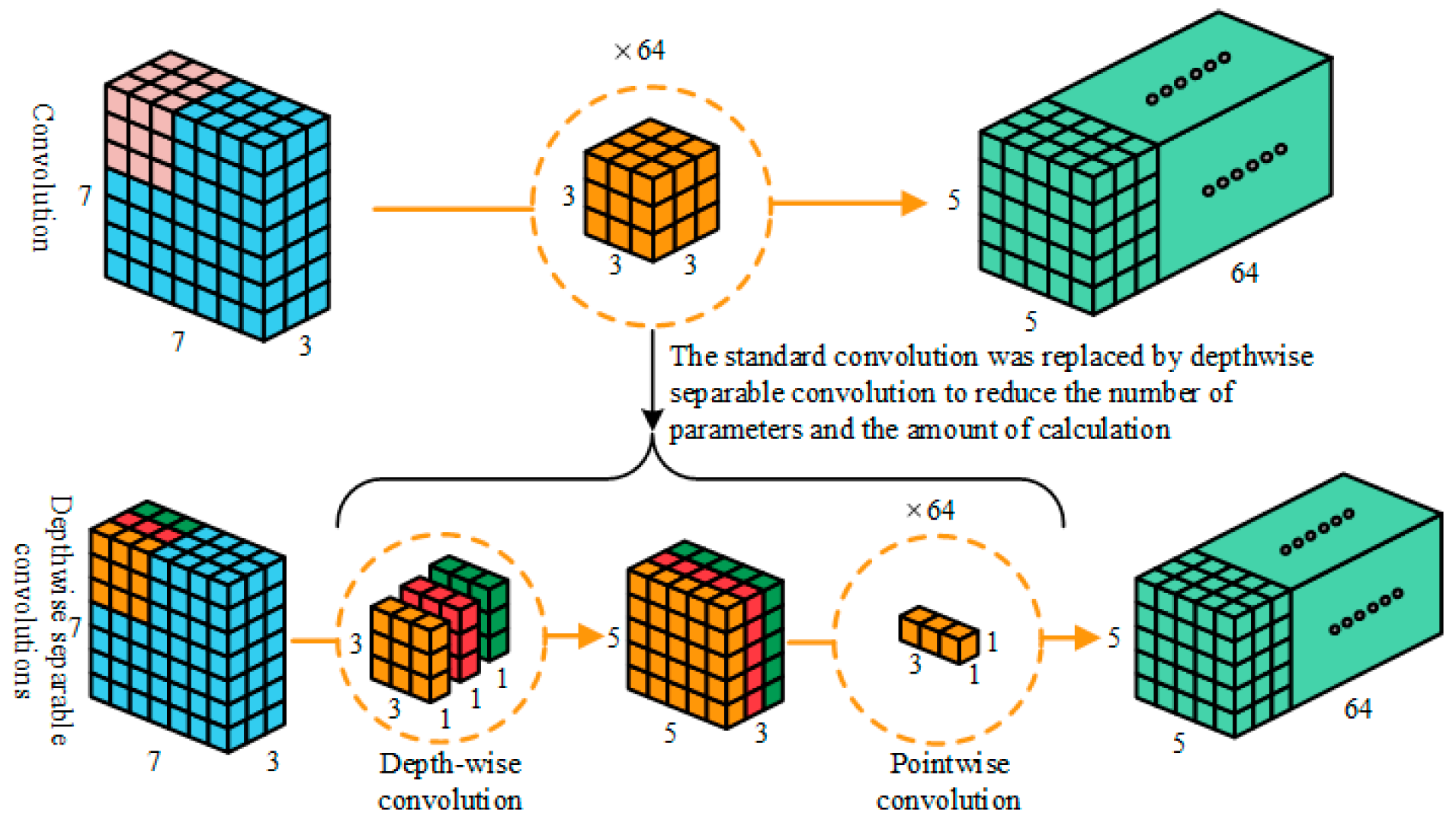
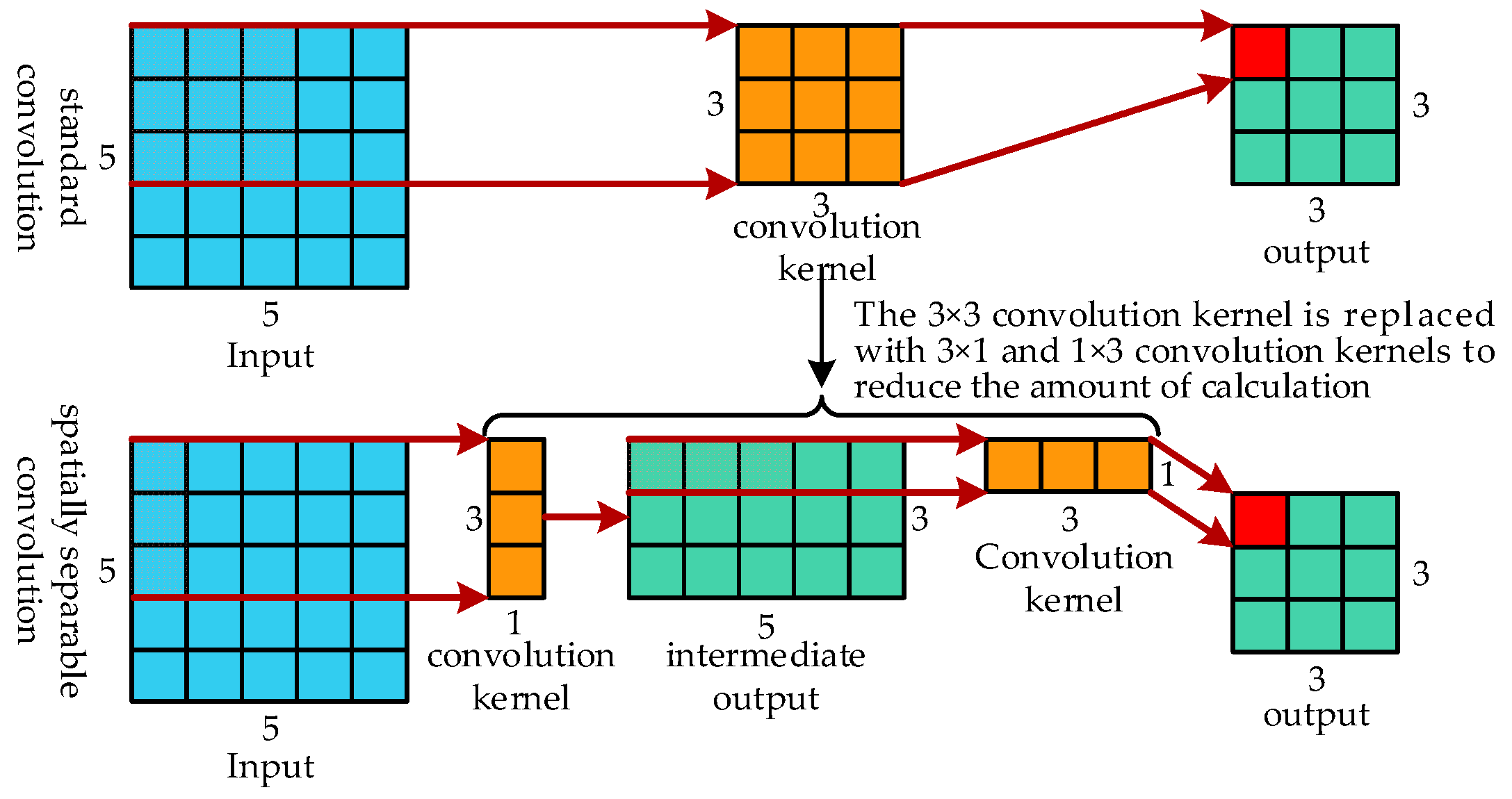
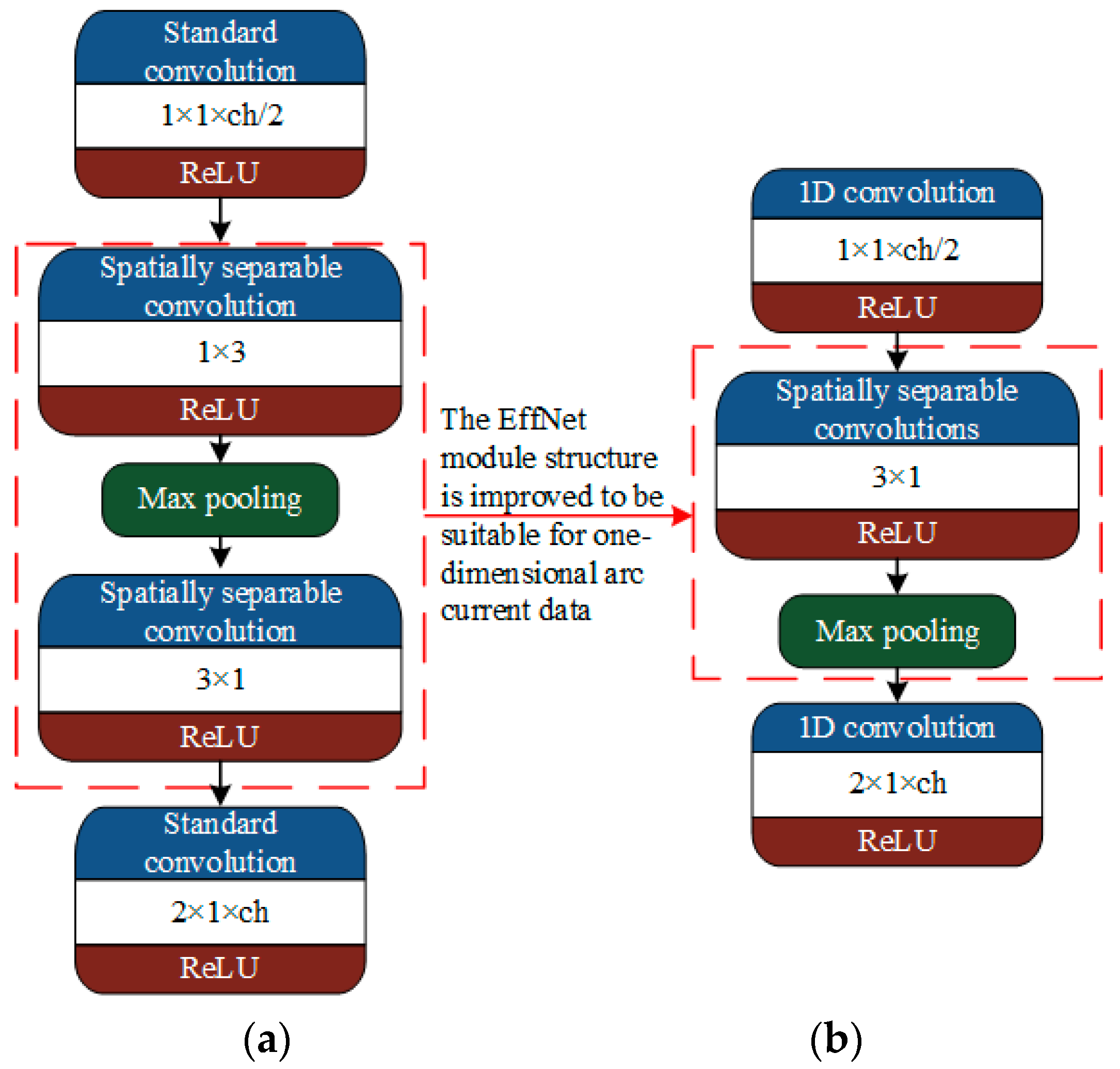
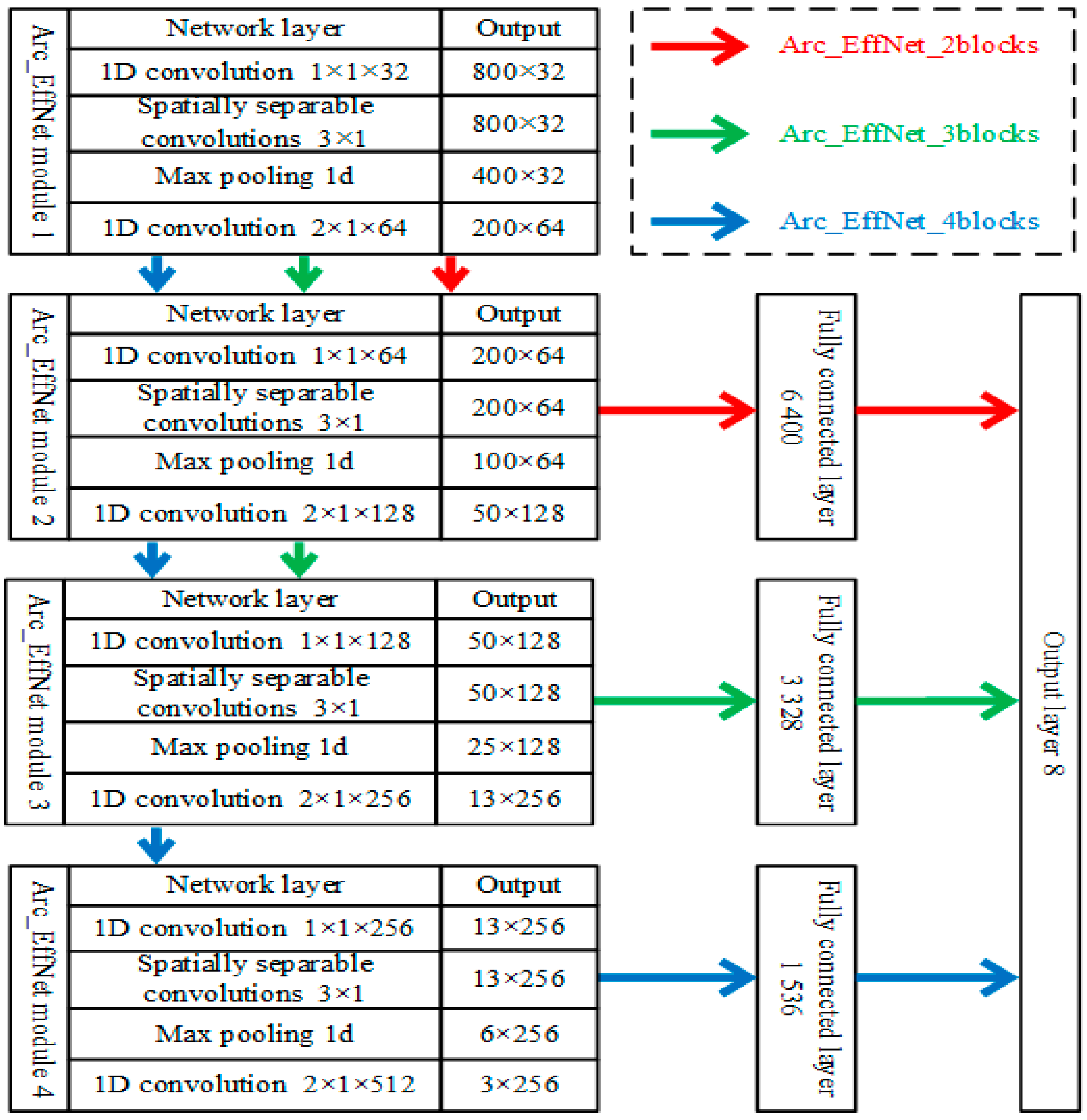
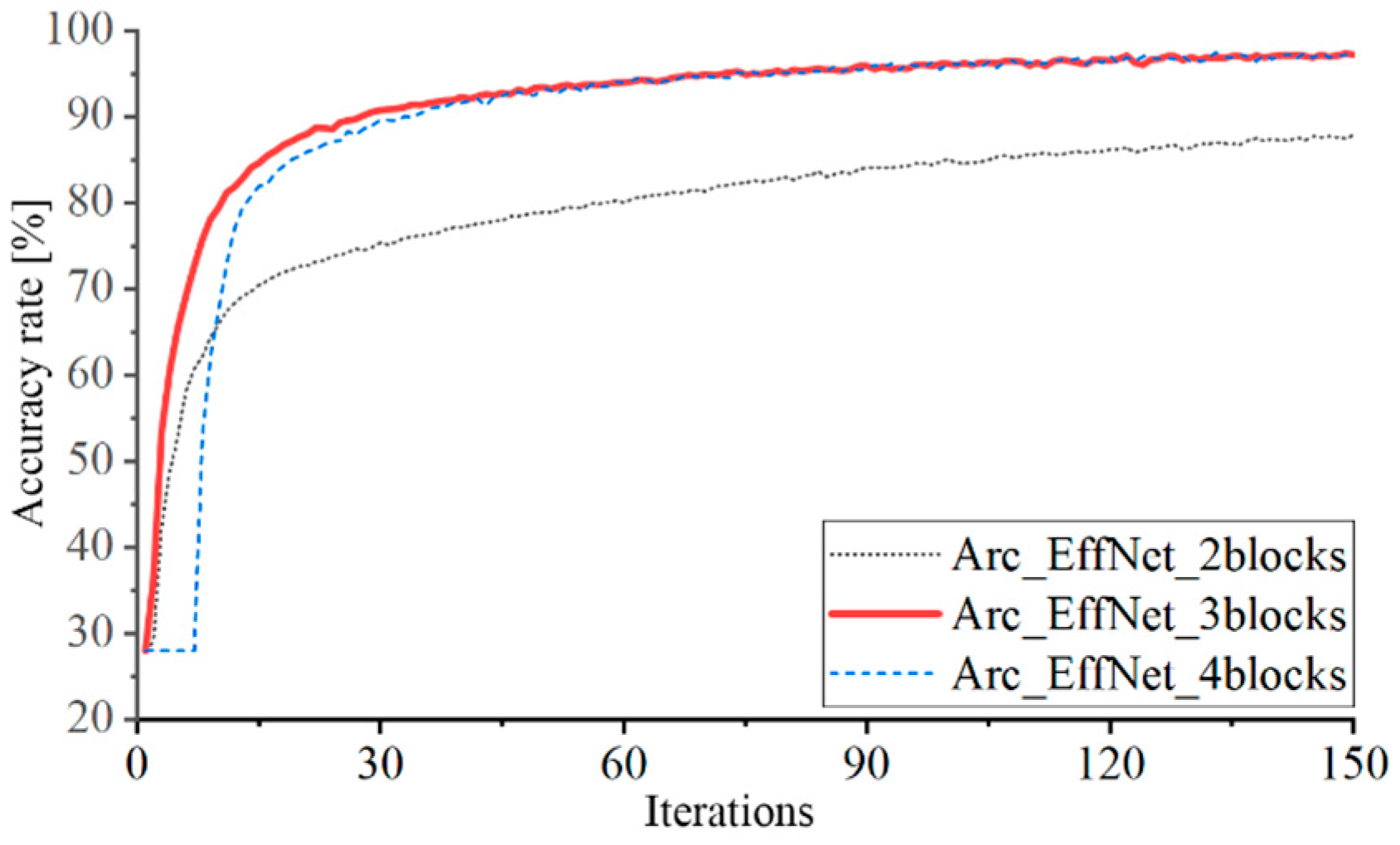
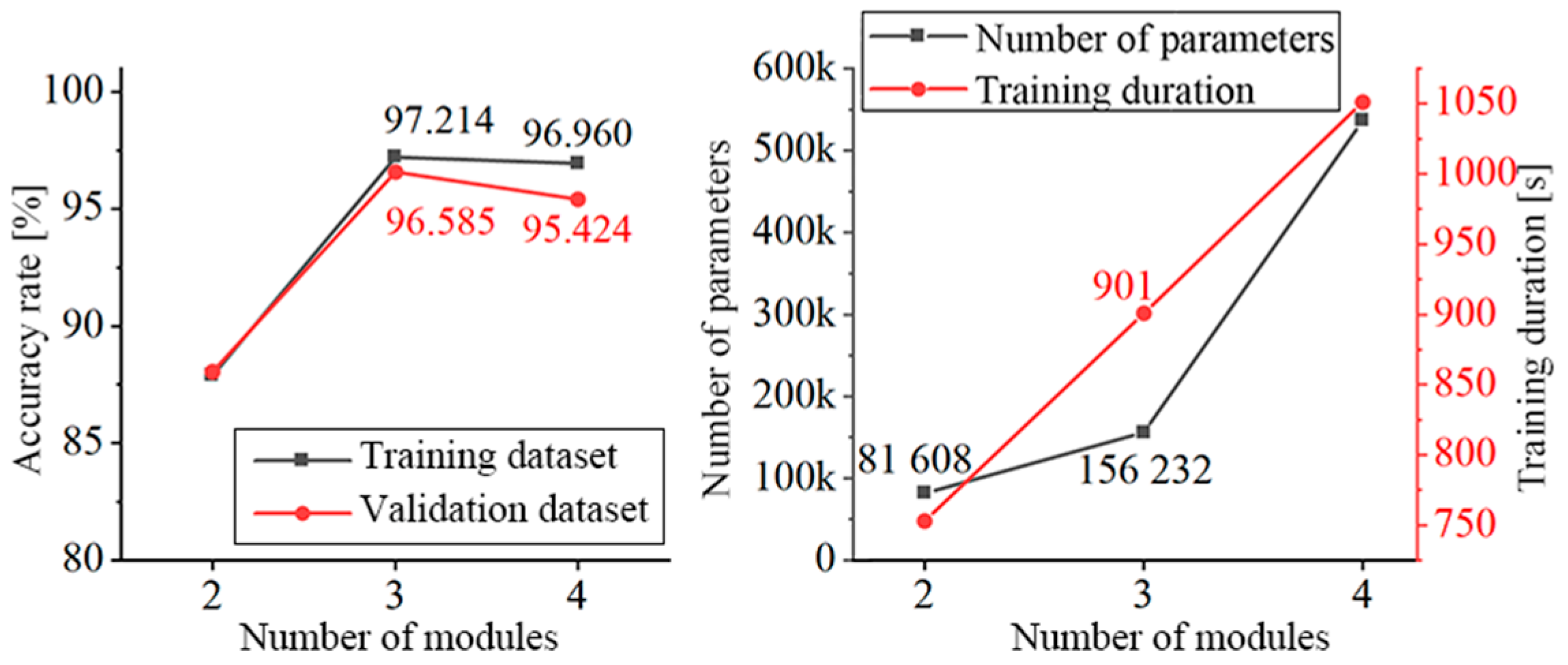
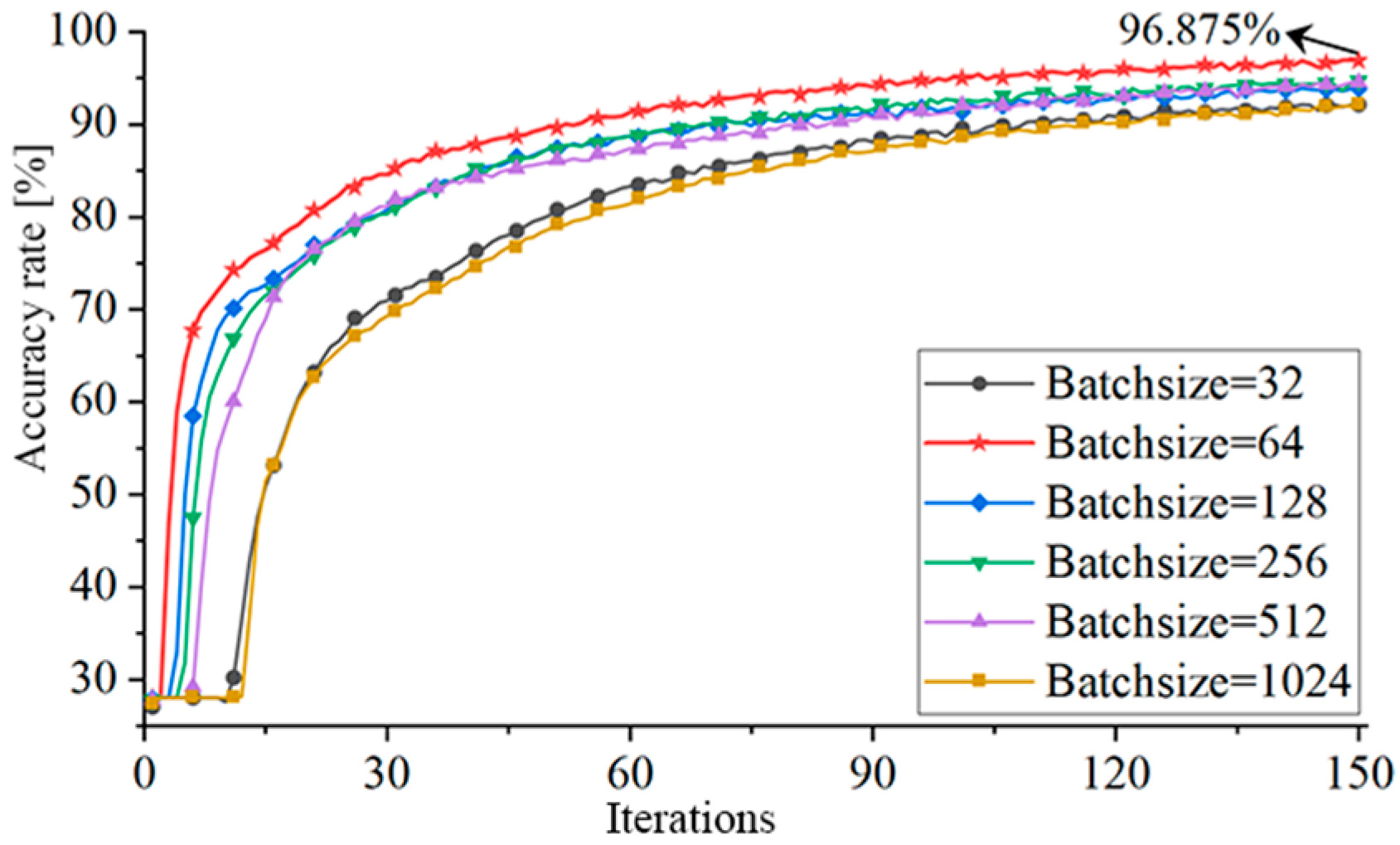
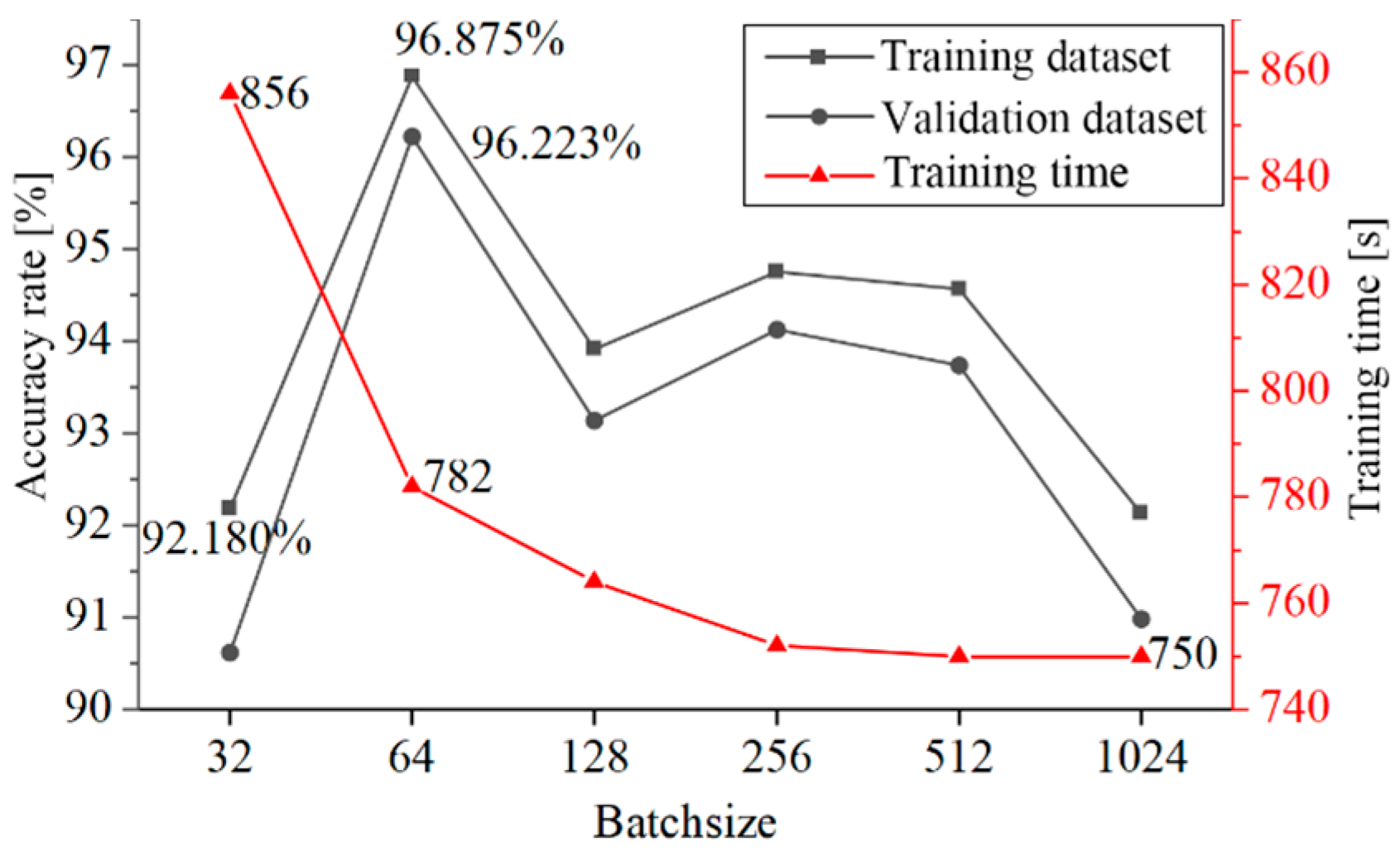


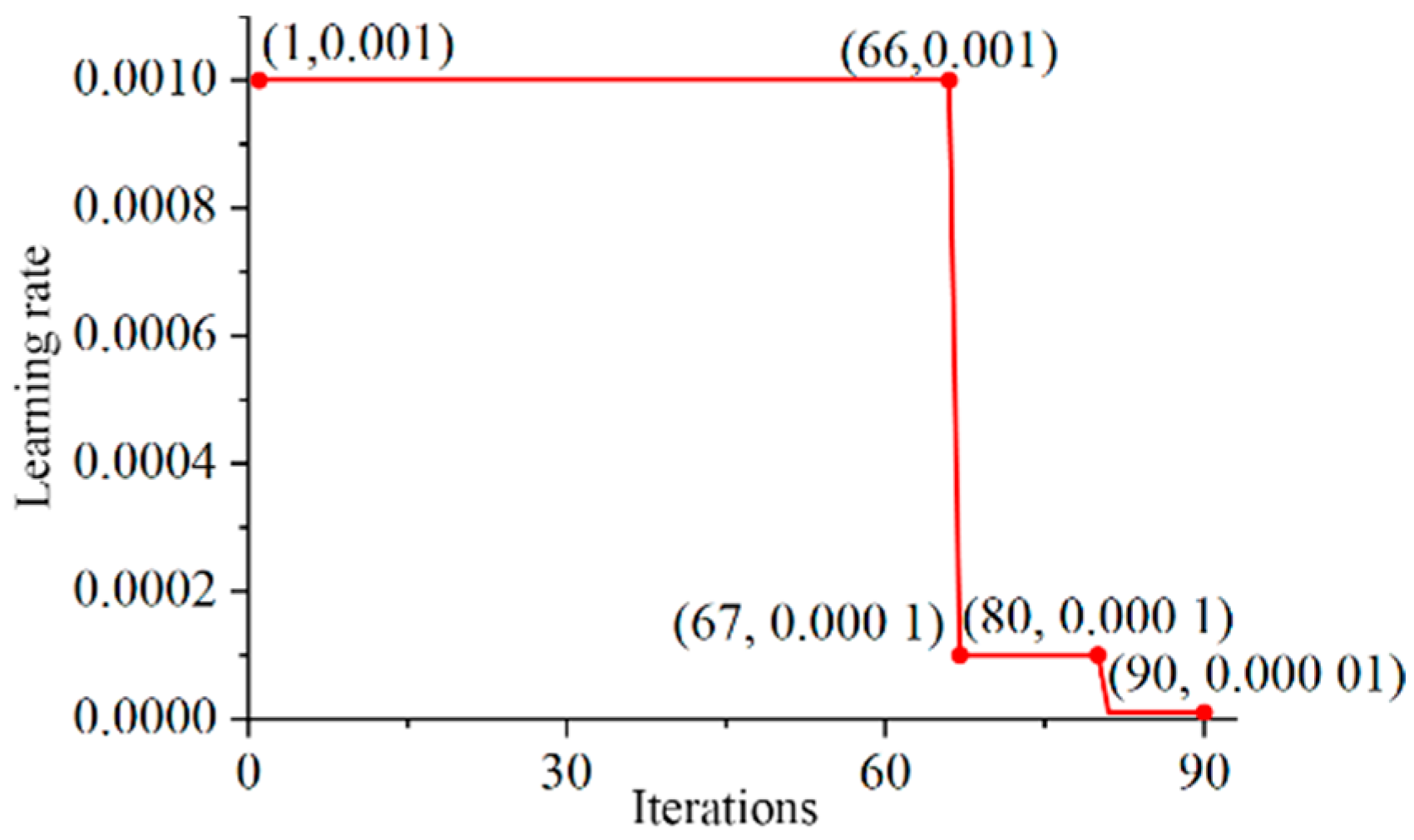
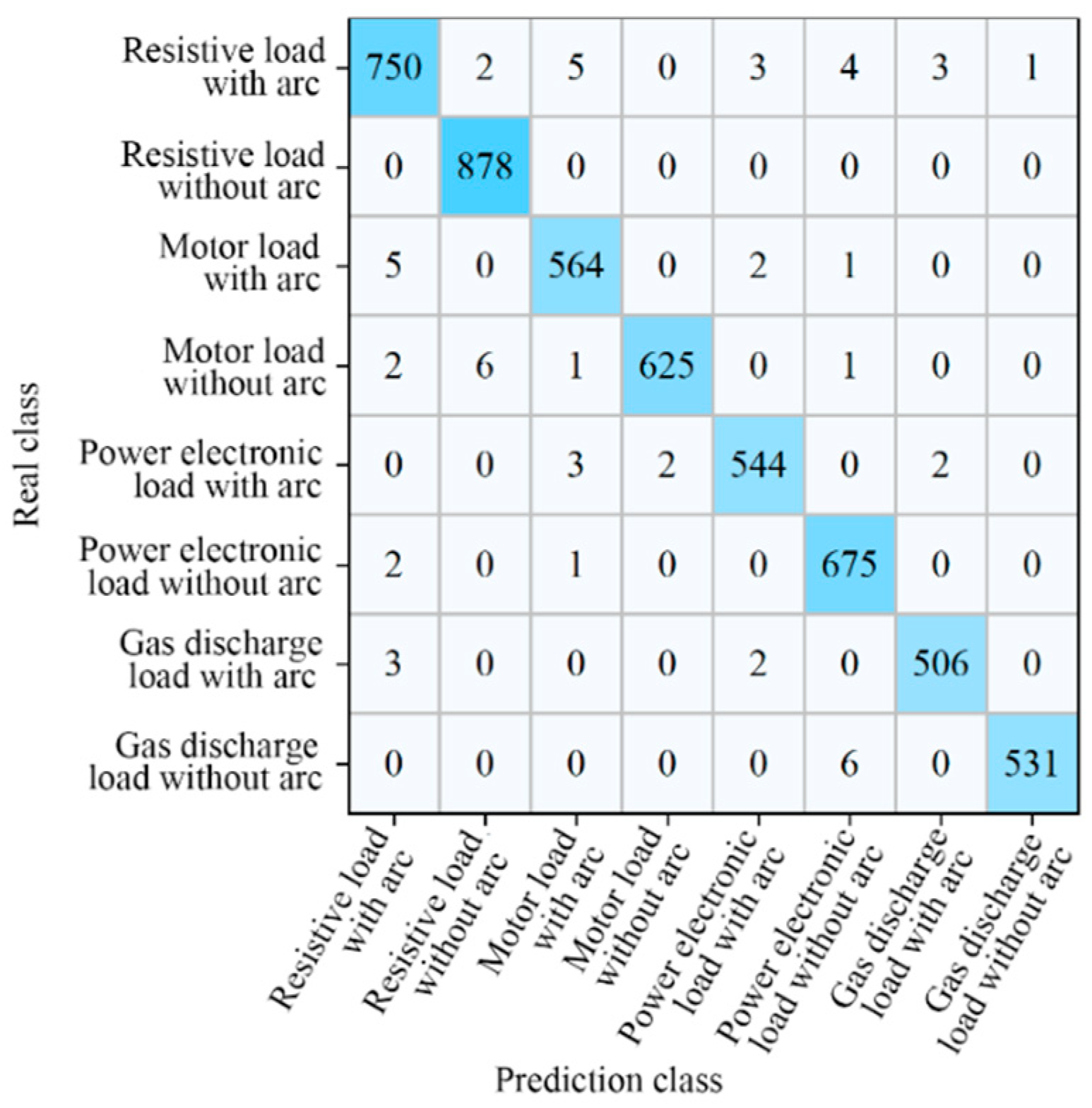

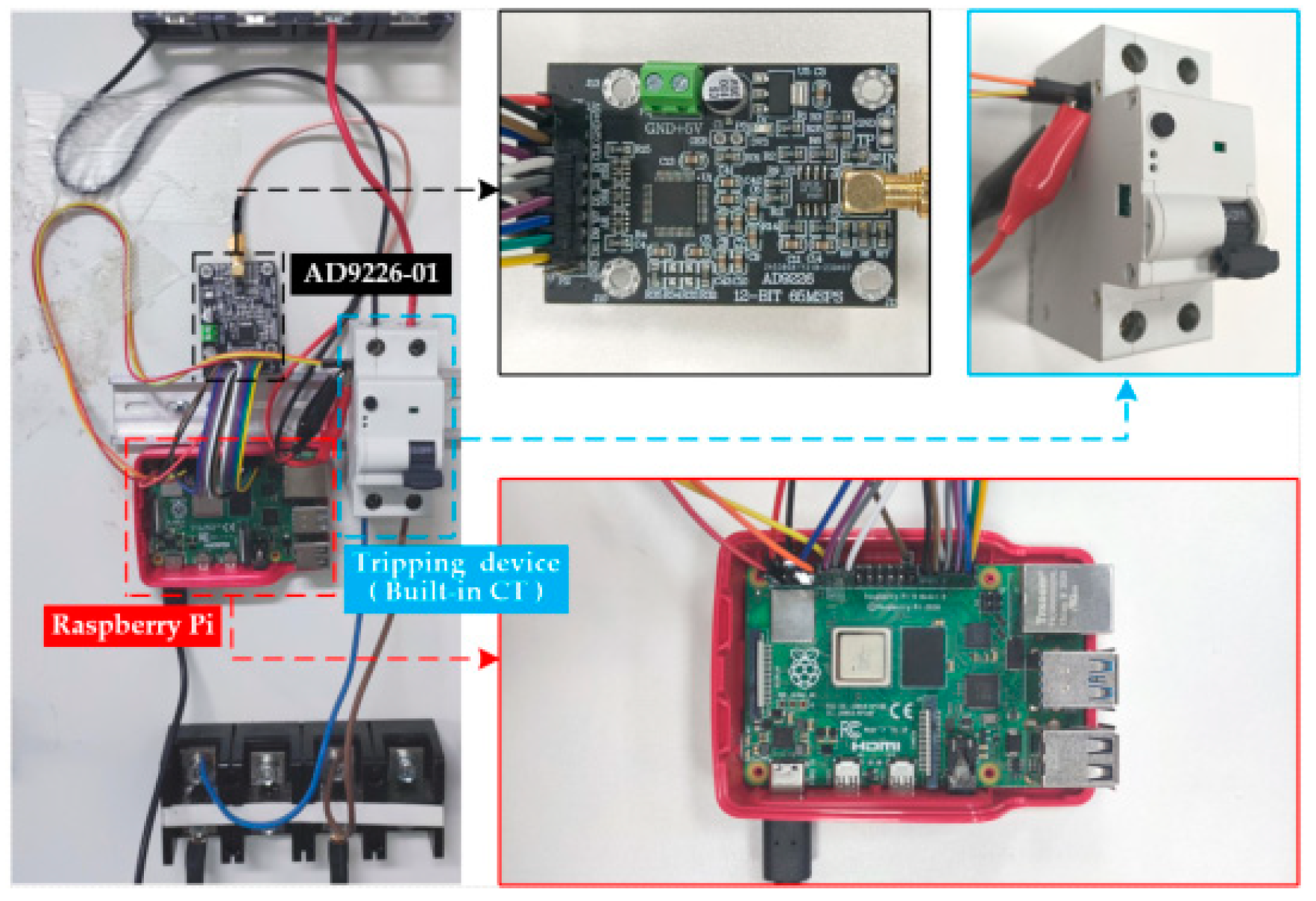
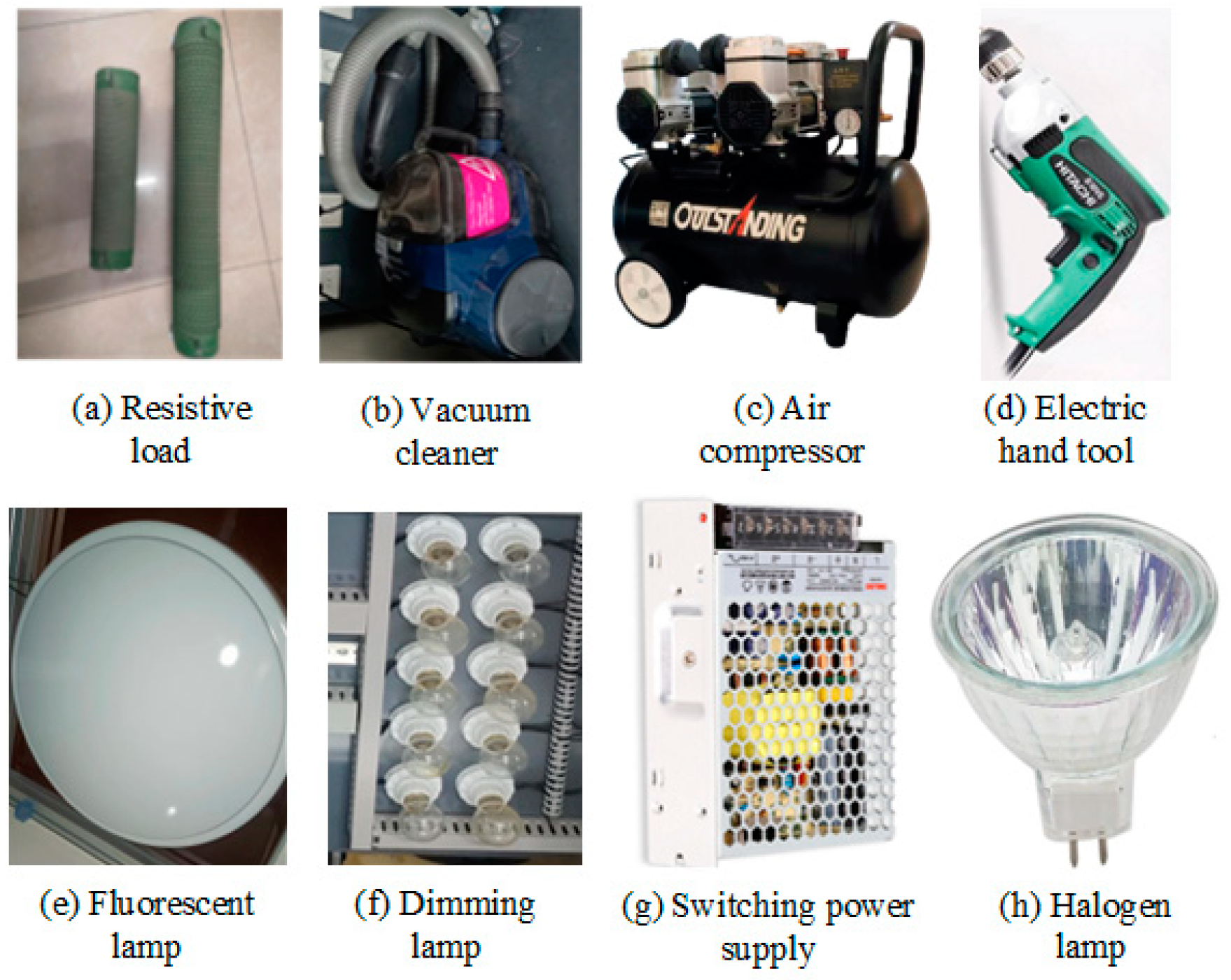
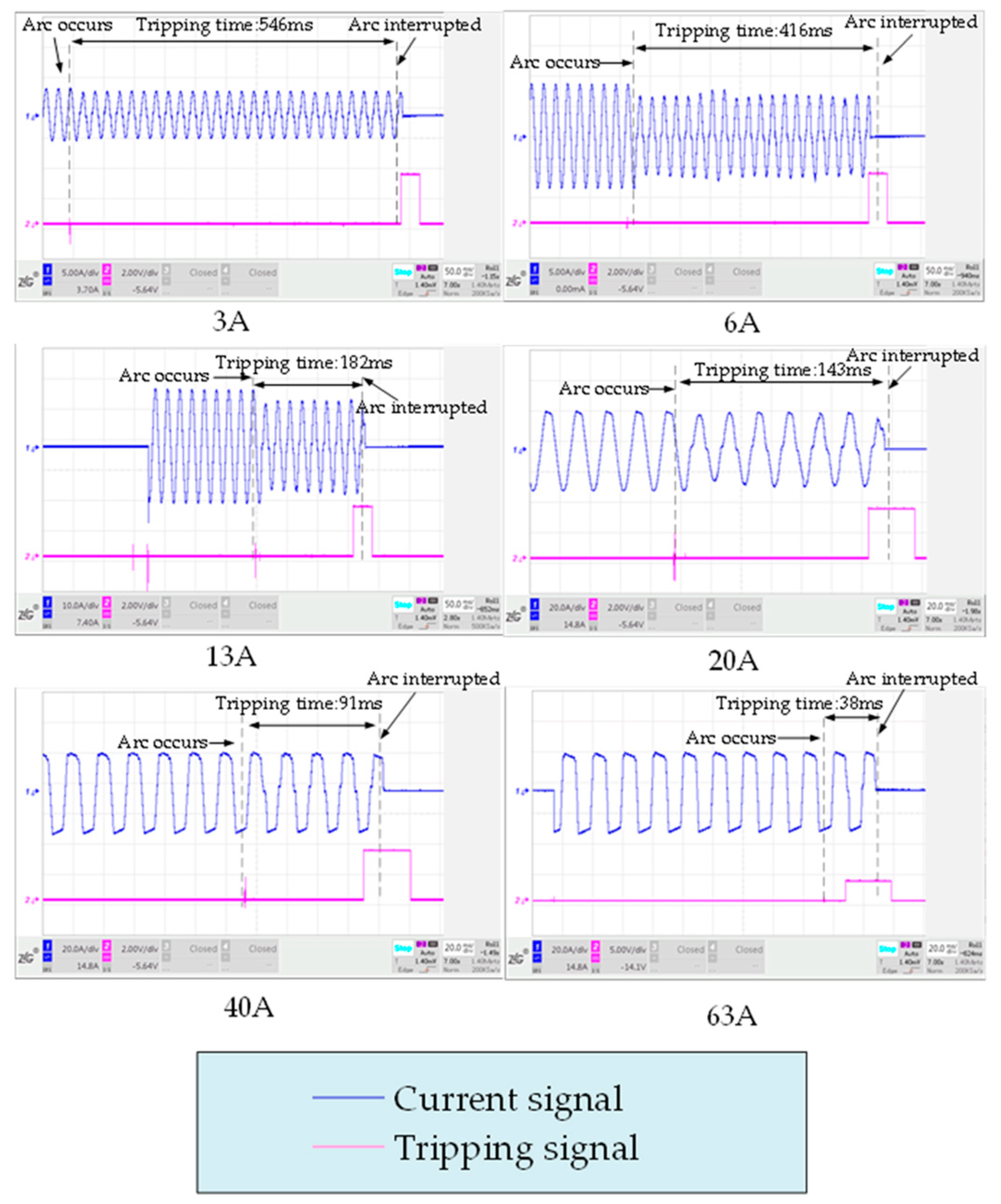

| Load Type | Load | Power | |
|---|---|---|---|
| Linear load | Resistive load | Resistor | - |
| Nonlinear load | Motor load | Vacuum cleaner | 1200 w |
| Air compressor | 2200 w | ||
| Electric hand tool | 650 w | ||
| Gas discharge lamp load | Fluorescent lamp | 900 w | |
| Dimming lamp | 1000 w | ||
| Power electronics load | Switching power supply | 700 w | |
| Halogen lamp | 1500 w | ||
| Method | Feature | Suitable for Arc Detection or Not |
|---|---|---|
| ADLNM [23] | more efficient convolution calculation | yes |
| CNNMC [24] | small decrease in accuracy and significant reduction in parameters | no |
| NAS [25] | long time for network design and cannot get rid of human influence | no |
| MobileNet [20] | ShuffleNet [26] | EffNet [27] | |||
|---|---|---|---|---|---|
| Network Layer | Data Amount | Network Layer | Data Amount | Network Layer | Data Amount |
| SC + P | 16,384 | SC + P | 16,384 | SC SSC + P SSC SC | 32,768 16,384 16,384 16,384 |
| DSC SC | 4096 8192 | GC DSC GC | 8192 2048 8192 | SC SSC + P SSC SC | 16,384 8192 8192 8192 |
| DSC SC | 2048 4096 | GC DSC GC | 4096 1024 4096 | SC SSC + P SSC SC | 8192 4096 4096 4096 |
| FC | 10 | FC | 10 | FC | 10 |
| Network Layer | Output Size | Parameter Amount |
|---|---|---|
| One-dimensional convolution (1 × 1 × 32) | 800 × 32 | 2560 |
| Spatially separable convolution (3 × 1) | 800 × 32 | 2560 |
| Max pooling | 400 × 32 | 1280 |
| One-dimensional convolution (2 × 1 × 64) | 200 × 64 | 1280 |
| Load Type | Signal Types | Label | One-Hot Coding | Training Samples | Test Samples | Validation Samples | Total Samples |
|---|---|---|---|---|---|---|---|
| Resistive load | arc | 0 | [1. 0. 0. 0. 0. 0. 0. 0.] | 3844 | 512 | 768 | 5124 |
| normal | 1 | [0. 1. 0. 0. 0. 0. 0. 0.] | 4392 | 585 | 878 | 5855 | |
| Motor load | arc | 0 | [0. 0. 1. 0. 0. 0. 0. 0.] | 2864 | 381 | 572 | 3817 |
| normal | 1 | [0. 0. 0. 1. 0. 0. 0. 0.] | 3177 | 423 | 635 | 4235 | |
| Gas discharge lamp load | arc | 0 | [0. 0. 0. 0. 1. 0. 0. 0.] | 2756 | 367 | 551 | 3674 |
| normal | 1 | [0. 0. 0. 0. 0. 1. 0. 0.] | 3394 | 452 | 678 | 4524 | |
| Power electronics load | arc | 0 | [0. 0. 0. 0. 0. 0. 1. 0.] | 2559 | 341 | 511 | 3411 |
| normal | 1 | [0. 0. 0. 0. 0. 0. 0. 1.] | 2689 | 358 | 537 | 3584 | |
| Total number of samples = | 25,675 | 3419 | 5 130 | 34,224 | |||
| Hyperparameter | Value | Hyperparameter | Value |
|---|---|---|---|
| Batchsize | 64 | min_lr | 0.00001 |
| lr | 0.001 | cooldown | 5 |
| lr_min_delta | 0.0001 | stop_min_delta | 0.00001 |
| lr_patience | 5 | stop_patience | 10 |
| factor | 0.1 |
| Predicted Class | Total | |||
| Actual Class | Arc | Normal | ||
| Arc | 2392 | 10 | 2402 | |
| Normal | 6 | 2722 | 2728 | |
| Total | 2398 | 2732 | 5130 | |
| Precision = | 99.75% | |||
| Recall = | 99.58% | |||
| Accuracy = | 99.69% | |||
| Embedded Platform | Advantage | Disadvantage |
|---|---|---|
| MAIX Dock | KPU can perform hardware acceleration | Complex model deployment, KPU can only accelerate part of the operation |
| Raspberry Pi 4B | Rapid deployment model by TensorFlow Lite | High costs |
| FPGA | More efficient operation | Development is difficult and time-consuming |
| Test Number | Sample Amount | Average Run-Time | Running Time Variance |
|---|---|---|---|
| 1 | 5130 | 0.201 ms | 0.0020 |
| 2 | 5130 | 0.20 ms | 0.0028 |
| 3 | 5130 | 0.202 ms | 0.0036 |
| 4 | 5130 | 0.199 ms | 0.0017 |
| 5 | 5130 | 0.20 ms | 0.0047 |
| Mean value | 5130 | 0.20 ms | 0.00296 |
| Parameter | Value | |
|---|---|---|
| Arc_cycles | 0~3 A | 25 |
| 3~6 A | 15 | |
| 6~13 A | 10 | |
| 13~20 A | 6 | |
| ≥20 A | 3 | |
| No_Arc_cycles | 0~6 A | 5 |
| 6~20 A | 3 | |
| ≥20 A | 1 | |
| δ | Resistance class | 0 |
| Motor class | 2 | |
| Gas discharge class | 1 | |
| Power electronics class | 3 | |
| Current (A) | Tripping Time | ||
|---|---|---|---|
| First Test | Second Test | Third Test | |
| 3 | 546 ms | 554 ms | 561 ms |
| 6 | 416 ms | 420 ms | 434 ms |
| 13 | 182 ms | 201 ms | 187 ms |
| 20 | 143 ms | 149 ms | 132 ms |
| 40 | 91 ms | 94 ms | 90 ms |
| 63 | 38 ms | 42 ms | 37 ms |
| Load Type | Tripping Time | |||
|---|---|---|---|---|
| A | B | C | D | |
| Vacuum cleaner | 234 ms | 257 ms | 243 ms | 224 ms |
| Air compressor | 176 ms | 186 ms | 180 ms | 191 ms |
| Electric hand tool | 152 ms | 149 ms | 153 ms | 163 ms |
| Fluorescent lamp | 102 ms | 112 ms | 109 ms | 117 ms |
| Halogen lamp | 239 ms | 251 ms | 253 ms | 244 ms |
| Dimming lamp | 198 ms | 211 ms | 196 ms | 220 ms |
| Switching power supply | 126 ms | 124 ms | 118 ms | 114 ms |
Disclaimer/Publisher’s Note: The statements, opinions and data contained in all publications are solely those of the individual author(s) and contributor(s) and not of MDPI and/or the editor(s). MDPI and/or the editor(s) disclaim responsibility for any injury to people or property resulting from any ideas, methods, instructions or products referred to in the content. |
© 2023 by the authors. Licensee MDPI, Basel, Switzerland. This article is an open access article distributed under the terms and conditions of the Creative Commons Attribution (CC BY) license (https://creativecommons.org/licenses/by/4.0/).
Share and Cite
Ning, X.; Sheng, D.; Zhou, J.; Liu, Y.; Wang, Y.; Zhang, H.; Lei, X. Arc_EffNet: A Novel Series Arc Fault Detection Method Based on Lightweight Neural Network. Electronics 2023, 12, 4617. https://doi.org/10.3390/electronics12224617
Ning X, Sheng D, Zhou J, Liu Y, Wang Y, Zhang H, Lei X. Arc_EffNet: A Novel Series Arc Fault Detection Method Based on Lightweight Neural Network. Electronics. 2023; 12(22):4617. https://doi.org/10.3390/electronics12224617
Chicago/Turabian StyleNing, Xin, Dejie Sheng, Jiawang Zhou, Yuying Liu, Yao Wang, Hua Zhang, and Xiao Lei. 2023. "Arc_EffNet: A Novel Series Arc Fault Detection Method Based on Lightweight Neural Network" Electronics 12, no. 22: 4617. https://doi.org/10.3390/electronics12224617
APA StyleNing, X., Sheng, D., Zhou, J., Liu, Y., Wang, Y., Zhang, H., & Lei, X. (2023). Arc_EffNet: A Novel Series Arc Fault Detection Method Based on Lightweight Neural Network. Electronics, 12(22), 4617. https://doi.org/10.3390/electronics12224617







